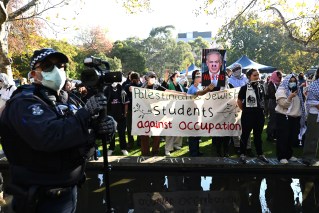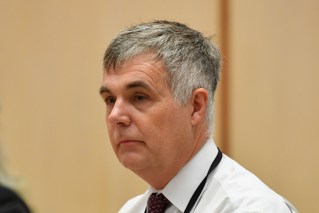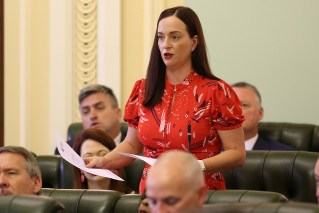‘Time is running out’: Experts’ warning after record seven-day temperatures

After the hottest seven-day run of average temperatures ever seen, experts have warned that the unwanted record will likely be broken in the near future.
Between July 4 and July 10, daily global average temperatures ranged from 17.11°C to 17.23°C, the highest ever recorded.
Kevin Trenberth, who was the lead author of the 1995, 2001 and 2007 Intergovernmental Panel on Climate Change scientific assessment, said the global temperatures on July 7 was the highest observed record.
“As far as we know, going back I would say 2000 years, that’s very likely the warmest,” he said.
“It is likely that 2023 will continue to be well above other years and will probably show up as the warmest year on record at the end of the year, but the odds are pretty good that 2024 could be even warmer still.”
Australia recently experienced three consecutive years of La Nina, a climate pattern in which sea surface temperatures across the Pacific Ocean are lower than normal, resulting in colder and wetter weather.
If an El Nino climate pattern develops with warming sea temperatures in the Pacific Ocean, then Australia can expect lower rainfall and warmer weather over the eastern half of the country.
Professor Trenberth said despite an El Nino climate pattern being likely to develop, temperature and climate patterns aren’t causing records to be broken.
“It plays a role, but it’s more of a consequence. The real cause of climate change is the change in the composition of the atmosphere, the build-up of greenhouse gases there and that produces extra heating,” he said.
“Unprecedented flood events are a key part of what is going on and then you have places where it’s not raining like in Texas, and Vermont just experienced flooding never seen before.”
Tweet from @bclemms
A weak target
Limiting global warming to a 1.5°C increase is the benchmark countries signed up for in the Paris Agreement in 2015, with an overarching goal of holding “the increase in the global average temperature to well below 2°C above pre-industrial levels”.
Professor Trenberth said even before the Paris Agreement set targets to limit global warming to 1.5°C, the target was “always out of sight”.
“Technically, if all emissions had stopped then it was feasible, but given the infrastructure and the rates of change of infrastructure and how long and cumbersome it is, there’s a 20-year lag before the effects of major changes really kick in and have a noticeable effect,” he said.
“I never thought 1.5°C was viable and I know a number of my Australian colleagues thought so as well.”
Professor Andrew Pitman, an atmospheric scientist at the University of New South Wales, said the target of 1.5°C was absolutely realistic when the first Intergovernmental Panel on Climate Change report came out in 1990 if emissions were cut at that time.
“Unfortunately, we twiddled our thumbs for 30 years, such that we’ve now warmed the planet by so much,” he said.
“There is a fascinating narrative around people saying we must keep warming 1.5°C, it’s not feasible anymore.”
He said keeping the ceiling on warming to 2°C is still possible, and it would not be an existential threat to humanity.
“We can adapt to 2°C, it would be really hard and it would be really expensive, and there would be some places that couldn’t adapt,” he said.
“There would be serious losers in a 2°C warmer world.”
The damage
Those “losers” will likely experience extreme weather events, including floods, bushfires, storms and drought.
Dr Lesley Hughes, climate councillor and distinguished professor at Macquarie University, said even 1.5°C will see a worsening of extreme weather events.
“More frequent and severe things like bushfires, droughts, floods, and storms. We are going into an El Nino period at the moment so that generally brings Australia droughts, reduced rainfall and a lot of heat,” Professor Hughes said.
“What climate change seems to be doing is intensifying that water cycle, so places that are normally dry are getting drier, places that normally get a lot of rainfall are getting more intense rainfall and we’re heading for even more extremes over the next decades.”
According to an international think tank, there could be as many as 1.2 billion climate refugees by 2050.
Professor Trenberth said this will contribute to global instability in unpredictable ways.
“All of these people coming into their countries, it will become a major issue with environmental refugees,” he said.
“I think that is really going to become a major issue, it is the sort of thing that can lead to regional conflict and wars, and a regional war can easily break out into something bigger.”
Offsets and targets
Professor Pitman said stronger targets than Australia’s current aim to be net zero by 2050 and the closing of carbon offset “accounting tricks” are needed.
“You need to get to near zero emissions by cutting emissions and then using offsets like planting forests for the tiny amount of emissions you can’t get to zero,” he said.
“One of every tenth of a degree matters, so it’s not 1.5°C or 2°C, 1.7°C is far more achievable than 1.5°C and 1.7°C is substantially better than 2°C.”
Currently, industries in Australia including coal mining and gas processing can purchase carbon credits from the Australian Government.
Their carbon emissions don’t change, but on paper they appear closer to net zero emissions.

Australia continues to be one of the world’s largest fossil fuel exporters. Photo: AAP
Professor Hughes said countries, including Australia, are waiting too long to substantially cut emissions.
“We’re not meeting our fairly weak target, and Australia has been judged to have some of the weakest climate policies and targets in the developed world,” she said.
“Time is running out to get on top of this, we’re continuing in Australia to give the green light to new fossil fuel developments and they are completely inconsistent with a safe climate.”








